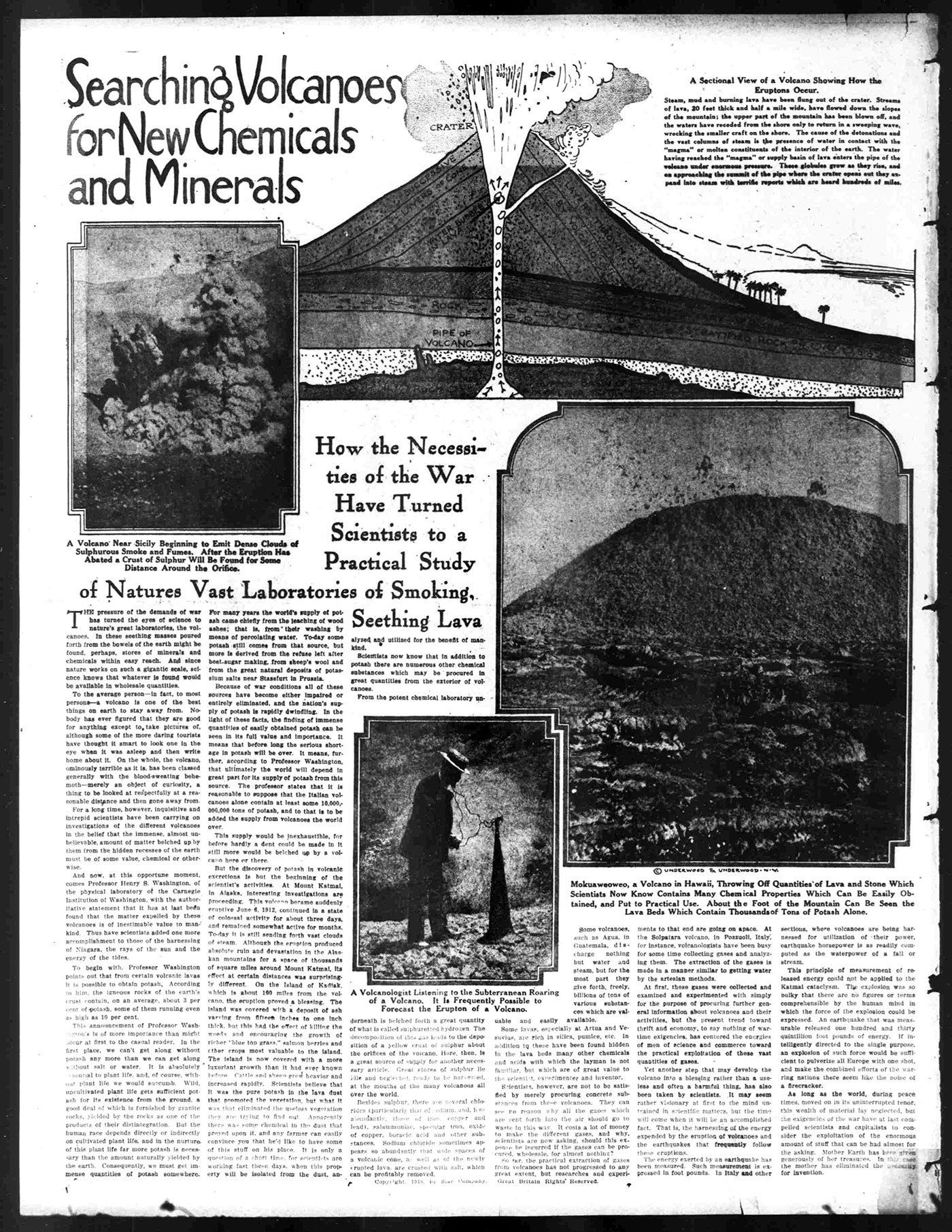Right to the Source
“Practical Use” of Volcanoes During Wartime
The Science Teacher—November/December 2020 (Volume 88, Issue 2)
By Kaleena Black

October 20, 1918, issue of The Washington Times. Library of Congress.
Volcanoes stir various reactions among people—from fear and panic, to awe and wonder. Yet, they have also motivated generations of explorations into their natural properties, as well as ways these might be harnessed and utilized. Specifically, the possibility of volcanoes serving as generators of energy and donors of beneficial nutrients has been of interest, as various articles in the Chronicling America newspaper database show—even during WWI.
An article in the October 20, 1918, issue of The Washington Times, “Searching Volcanoes for New Chemicals and Minerals: How the Necessities of the War Have Turned Scientists to a Practical Study of Natures [sic] Vast Laboratories of Smoking, Seething Lava,” is an example that offers opportunities for interdisciplinary study.
Published less than a month before the armistice ending WWI, the article includes a diagram depicting volcanic features and functions, and photographs. It also describes some endeavors of scientists to identify, source, and explore the utility of volcanic materials, including potash found in volcanic ash, sulfur, sodium chloride, various gases, and more.
The specific focus on potash—compounds formed with potassium, which can be an ingredient in fertilizers—for agricultural benefits may prompt some cross-curricular research for your students. Before WWI, most of the United States’ potash supply came from Germany. During the war, however, these imports were halted. With increasing demand and decreasing supply, there was interest in locating new, available, and inexpensive sources of potash within the United States.
Given the need in that context, possibilities for repurposing volcanic materials for new uses might have seemed intriguing, and perhaps, promising at the time. For example, the article mentioned Dr. Henry S. Washington, a scientist at the Carnegie Institution of Washington, who had apparently suggested the potential to collect potash from lava. It also described the major 1912 eruption of Mount Katmai in Alaska, detailing the destruction in the immediate area, and yet an observed increase in crop growth—perhaps, due to volcanic ash, according to the article—on nearby Kodiak Island. (More modern research has advocated alternative reasons for these observations on Kodiak Island.)
Ultimately, after the war, more viable sources of potash—besides volcanoes—were identified. Still, this article’s focus on a quest to explore new (and natural) technologies in response to a national challenge might inspire student research. More broadly, it reflects themes about environmental science, geology, ethics regarding natural resources, and alternative and renewable energy. Upon closer examination, it might also encourage a deeper investigation into intersecting topics like history, economics, international relations, and technology—in the 20th century and beyond.
About the Source
The article featured here can be found in Chronicling America (https://chroniclingamerica.loc.gov), a digital database of historical newspapers developed and supported through a partnership between the Library of Congress and the National Endowment for the Humanities. Additional articles related to exploration of volcanoes and their potential applications– for instance, in the area of geothermal energy, are also available. Suggested search terms include: “volcano energy” or “volcano power,” and narrowing your search to the first quarter of the 20th century may be helpful.
Your students may also wish to explore these other related resources from the Library of Congress:
“Krakatoa Volcano Eruption: Topics in Chronicling America”: https://guides.loc.gov/chronicling-america-krakatoa-volcano
“Icy Volcanism in the Outer Solar System Lecture on September 16” (2015; Inside Adams blog): https://blogs.loc.gov/inside_adams/2015/09/icy-volcanism-in-the-outer-solar-system-lecture-on-september-16/
“Earthquakes, Hurricanes, and Other Natural Disasters” (2011; Inside Adams blog): https://blogs.loc.gov/inside_adams/2011/08/earthquakes-hurricanes-and-other-natural-disasters/
“Science Reference Guides - Natural Disasters: A Guide to Selected Resources”: https://www.loc.gov/rr/scitech/SciRefGuides/naturaldisasters.html
Kaleena Black (kblack@loc.gov) is an Educational Resources Specialist at the Library of Congress.
Earth & Space Science Instructional Materials Literacy High School


